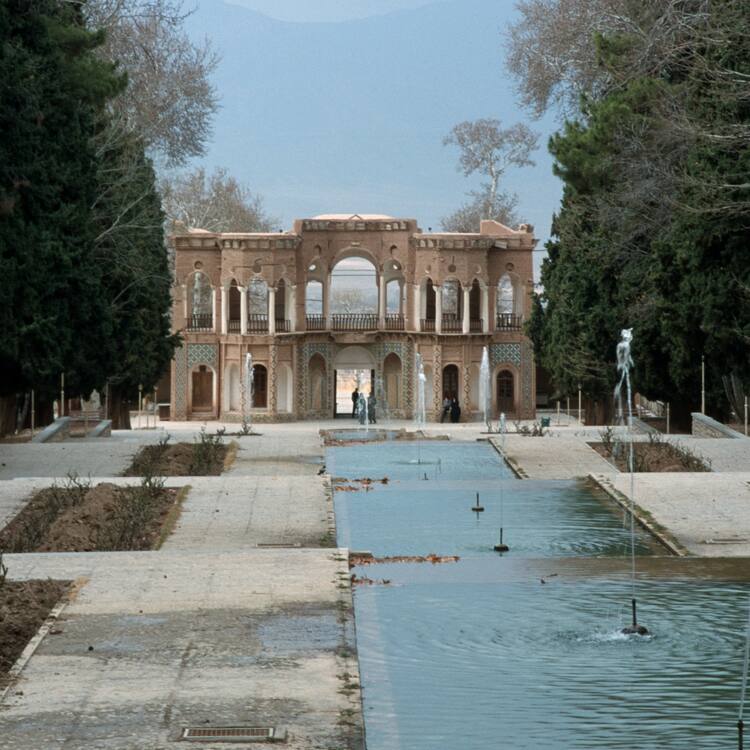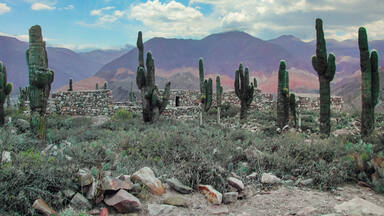The Persian Garden
The Persian Garden
The property includes nine gardens in as many provinces. They exemplify the diversity of Persian garden designs that evolved and adapted to different climate conditions while retaining principles that have their roots in the times of Cyrus the Great, 6th century BC. Always divided into four sectors, with water playing an important role for both irrigation and ornamentation, the Persian garden was conceived to symbolize Eden and the four Zoroastrian elements of sky, earth, water and plants. These gardens, dating back to different periods since the 6th century BC, also feature buildings, pavilions and walls, as well as sophisticated irrigation systems. They have influenced the art of garden design as far as India and Spain.
Description is available under license CC-BY-SA IGO 3.0
Le jardin persan
Le site comprend neuf jardins dans diverses régions d'Iran. Ils témoignent de la diversité des jardins paysagers persans qui ont évolué et se sont adaptés aux différentes conditions climatiques, tout en restant fidèles aux principes du concept original qui remonte aux temps de Cyrus le Grand, au VIe siècle av. J.-C. Toujours divisé en quatre secteurs et accordant à l'eau un rôle central (tant pour l'irrigation que pour l'esthétique), le jardin persan a été conçu pour symboliser l'Eden et les quatre éléments zoroastriens : le ciel, la terre, l'eau et les végétaux. Ces jardins datent de périodes différentes depuis le VIe siècle av. J.-C. et ils comportent aussi des bâtiments, pavillons et murs, ainsi que des systèmes d'irrigation sophistiqués. Ils ont influencé l'art du jardin paysager jusqu'en Inde et en Espagne.
Description is available under license CC-BY-SA IGO 3.0
الحديقة الفارسية
يشمل الموقع تسع حدائق في تسع مقاطعات مختلفة تجسد تنوُّع أشكال الحدائق الفارسية التي تم تطويرها وتكييفها مع الظروف المناخية المتبدلة علماً بأنها ظلت ترتكز على مبادئ فنية تعود جذورها إلى عصر قورش الكبير الذي عاش في القرن السادس قبل الميلاد. وتتألف الحديقة الفارسية دائماً من أربعة أقسام يؤدي فيها عنصر المياه دوراً مهماً لأغراض الري والتزيين. والهدف من تصميم الحدائق الفارسية هو محاكاة حدائق عدن وتجسيد العناصر الأربعة للديانة الزرادشتية أي السماء والأرض والمياه والنباتات. وتضم هذه الحدائق التي يعود تاريخ تصميمها إلى حقب مختلفة اعتباراً من القرن السادس قبل الميلاد عدداً من المنشآت والأجنحة والجدران، فضلاً عن نظم دقيقة للري، وقد تركت تأثيراً على فن تصميم الحدائق في الهند وإسبانيا.
source: UNESCO/CPE
Description is available under license CC-BY-SA IGO 3.0
波斯园林
这一文化遗产由分布在9个省份的9座园林共同组成。它们一方面体现了自公元前6世纪居鲁士大帝时期以来形成的波斯园林设计原则,另一方面也展现了波斯园林为适应各种气候条件而发展出来的多样风格。波斯园林的主要设计理念突出了对伊甸园及琐罗亚斯德教四大元素——天空、水、大地、植物的象征意象,所有园林都分为四个部分,并且水在园林的灌溉与装饰中发挥了重要的作用。这九座园林分别建设于不同时期,最早的可以追溯到公元前6世纪。楼台、亭榭、墙垣以及精密的水流灌溉系统是园林的重要特征。波斯园林对印度及西班牙园林艺术都产生了影响。
source: UNESCO/CPE
Description is available under license CC-BY-SA IGO 3.0
Персидский сад
Объект включает девять садов – по числу иранских провинций. В них отражается разнообразие в подходе к проектированию персидских садов. Со временем оно претерпевало изменения и приспосабливалось к различным климатическим условиям. Но при этом сохранялись принципы, уходящие своими корнями во времена Кира Великого, жившего в 6-м веке до н.э. Каждый персидский сад состоит из четырех секторов. Важная роль отводится воде – это и источник жизнеобеспечения, и элемент украшения. Персидский сад задумывался как воплощение Рая в сочетании четырех зороастрийских элементов – неба, земли, воды и растительности. На территории садов, создававшихся в различные периоды, начиная с 6-го века до н.э., возводились здания, павильоны и стены, строились сложные системы орошения. Они оказали влияние на искусство планировки садов Индии и Испании.
source: UNESCO/CPE
Description is available under license CC-BY-SA IGO 3.0
El jardín persa
Este sitio comprende nueve jardines situados en varias provincias del Irán. Estos jardines ejemplifican la diversidad del arte paisajístico persa que supo evolucionar y adaptarse a condiciones climáticas diferentes, conservando siempre sus principios fundamentales que se remontan a los tiempos de Ciro el Grande (siglo VI a.C.). Caracterizado por su división en cuatro sectores y por la omnipresencia del agua como elemento de irrigación y ornamentación, el jardín persa se concibió como un símbolo del Edén y de los cuatro elementos zoroástricos: el cielo, la tierra, el agua y el mundo vegetal. Los jardines que forman el sitio datan de épocas diferentes –desde el siglo VI a.C.– y comprenden también edificios, pabellones, murallas y sistemas de regadío complejos. Su influencia en el arte de la jardinería paisajística llegó a extenderse hasta la India y España.
source: UNESCO/CPE
Description is available under license CC-BY-SA IGO 3.0
ペルシャ庭園
イラン各地に点在する9つの庭園から成る。紀元前6世紀のキュロス王時代を起源とした原理を保ちつつ、さまざまな気象条件に合わせて発展、適応させた多様なペルシャ庭園様式の代表例。庭園は、灌漑と鑑賞の両方の役割を持つ水路によって、常に4区画に分割され、エデンの園、ゾロアスター教の天・地・水・植物の4元素を象徴するよう構想された。以来さまざまな時代に造られ、建造物、パビリオン、周壁、洗練された灌漑システムが特徴である。こうした庭園設計術は、インドやスペインにまで影響を与えた。source: NFUAJ
Perzische tuin
Deze site omvat negen tuinen in evenveel provincies. Ze illustreren de diversiteit van Perzische tuinontwerpen – ontwikkeld en aangepast aan verschillende klimatologische omstandigheden – met behoud van beginselen uit de tijd van Cyrus de Grote (6e eeuw voor Christus). De tuinen zijn altijd verdeeld in vier sectoren, met een belangrijke rol voor water als versieringselement en irrigatie. De Perzische tuin werd ontworpen om Eden en de vier zoroastrische elementen van hemel, aarde, water en planten te symboliseren. De tuinen dateren uit verschillende periodes en bevatten ook gebouwen, paviljoens en muren. Ze hebben grote invloed gehad op tuinontwerpen van India tot in Spanje.
Source: unesco.nl
Outstanding Universal Value
Brief synthesis
The Persian Garden consists of a collection of nine gardens, selected from various regions of Iran, which tangibly represent the diverse forms that this type of designed garden has assumed over the centuries and in different climatic conditions. They reflect the flexibility of the Chahar Bagh, or originating principle, of the Persian Garden, which has persisted unchanged over more than two millennia since its first mature expression was found in the garden of Cyrus the Great's Palatial complex, in Pasargadae. Natural elements combine with manmade components in the Persian Garden to create a unique artistic achievement that reflects the ideals of art, philosophical, symbolic and religious concepts. The Persian Garden materialises the concept of Eden or Paradise on Earth.
The perfect design of the Persian Garden, along with its ability to respond to extreme climatic conditions, is the original result of an inspired and intelligent application of different fields of knowledge, i.e. technology, water management and engineering, architecture, botany and agriculture. The notion of the Persian Garden permeates Iranian life and its artistic expressions: references to the garden may be found in literature, poetry, music, calligraphy and carpet design. These, in turn, have inspired also the arrangement of the gardens. The attributes that carry Outstanding Universal Value are the layout of the garden expressed by the specific adaptation of the Chahar Bagh within each component and articulated in the kharts or plant/flower beds; the water supply, management and circulation systems from the source to the garden, including all technological and decorative elements that permit the use of water for functional and aesthetic exigencies; the arrangement of trees and plants within the garden that contribute to its characterisation and specific micro-climate; the architectural components, including the buildings but not limited to these, that integrate the use of the terrain and vegetation to create unique manmade environments; the association with other forms of art that, in a mutual interchange, have been influenced by the Persian Garden and have, in turn, contributed to certain visual features and sound effects in the gardens.
Criterion (i): The Persian Garden represents a masterpiece of human creative genius. The design of the Persian Garden, based on the right angle and geometrical proportions, is often divided into four sections known as Chahar Bagh (Four Gardens). The creation of the Persian Garden was made possible due to intelligent and innovative engineering solutions and a sophisticated water-management system, as well as the appropriate choice of flora and its location in the garden layout. Indeed, the Persian Garden has been associated with the idea of earthly Paradise, forming a stark contrast to its desert setting.
Criterion (ii): The Persian Garden exhibits an important interchange of human values, having been the principal reference for the development of garden design in Western Asia, Arab countries, and even Europe. It is the geometry and symmetry of the architecture, together with the complex water management system, that seem to have influenced design in all these gardens. The word Paradise entered European languages from the Persian root word "Pardis", which was the name of a beautiful garden enclosed behind walls.
Criterion (iii): The Persian Garden bears exceptional, and even unique, testimony to the cultural traditions that have evolved in Iran and the Middle East over some two and a half millennia. Throughout its evolution, the Persian Garden has had a role in various cultural and social aspects of society, becoming a central feature in private residences, palaces and public buildings, as well as in ensembles associated with benevolent or religious institutions, such as tombs, park layouts, palace gardens, Meidans, etc.
Criterion (iv): The Persian Garden is an outstanding example of a type of garden design achieved by utilising natural and human elements and integrating significant achievements of Persian culture into a physical and symbolic-artistic expression in harmony with nature. Indeed, the Persian Garden has become a prototype for the geometrically-designed garden layout, diffused across the world.
Criterion (vi): The Persian Garden is directly associated with cultural developments of Outstanding Universal Value. These include literary works and poetry for example by Sa'di, Hafez and Ferdowsi. The Persian Garden is also the principal source of inspiration for the Persian carpet and textile design, miniature painting, music, architectural ornaments, etc. In the Avesta, the ancient holy book of the Zoroastrians, the Persian Garden and its sacred plants are praised as one of the four natural elements (earth, heavens, water, and plants). The Chahar Bagh is a reflection of the mythical perception of nature, and the cosmic order in the eyes of the ancient Iranian peoples.
Integrity
The Persian Garden comprises a sufficient number of gardens from across Iran and each garden contains sufficient elements to concur to express the Outstanding Universal Value of the series. The component gardens are in good condition and well maintained.
Authenticity
The Persian Garden, through its components, has developed alongside the evolution of the Persian society, while adhering to its early geometric model, the Chahar Bagh. Pasargadae and Bagh-e Abas Abad may be read as fossil landscapes while the other seven gardens retain their active role within their physical and social contexts.
Protection and Management requirements
Each garden is registered in the National Heritage List and therefore protected according to the Iranian legislation. Protection provisions established for the gardens and their 'buffer zones', defined according to the Iranian law in force, are also included in the Master Plans, the approval of which is issued by the Higher Council for Architecture and Urban Planning, in which sits also the Head of the Iranian Cultural Heritage, Handicrafts and Tourism Organisation (ICHHTO).
The existence of the National ICHHTO Base for the Persian Garden ensures that the management framework is one for the whole series, granting the coordination and harmonisation of strategies and objectives. The Management Plan includes objectives common to all component gardens of the series and a programme for strengthening presentation and promotion to the public has been developed.




